O Canada
In the U.S., the various code bodies got together in 1999 to create the International Code Council (ICC). However, it is important to determine if the International Codes (I-Codes), National Fire Protection Association (NFPA) or Occupational Safety and Health Administration (OSHA) codes apply. In Canada, things are simpler. The National Building Code (NBC) governs all construction.
Canada’s National Research Council assembles the NBC. Published on a five-year cycle, 2020 is the most recent. As with the I-Codes, the NBC is a minimum standard for safety and a model code. Local jurisdictions and provinces don’t have the human resources to write code. Instead, they will adopt the model code and may choose to make it more conservative or liberal.
The NBC doesn’t apply until adopted by the local jurisdiction. Thus, the more current version may not be in effect in your province. This reinforces the need to check with the authority having jurisdiction—confirming expectations before construction. Canadian codes are “prescriptive”. The wording is often open to interpretation by the local inspector.
Handrail
A handrail provides guidance and support. Refer to this table to determine the number of handrails required:
| Location of Stair or Ramp | Handrail Serving Stairs | Handrails Serving Ramps | |||
| Stairs <1100mm (43”) Wide | Stairs ≥ 1100mm (43”) Wide | Ramps < 1100 mm (43”) Wide | Ramps ≥ 1100 mm (43”) Wide | ||
Straight | Curved | All | Straight or Curved | All | |
Number of Sides Required to Have a Handrail | |||||
| Within a dwelling unit or a house with a secondary suite | 1 | 1 | 1 | 1 | 2 |
| All other locations | 1 | 2 | 2 | 2 | 2 |
Handrails must be continuously “graspable”. The expectation is that the user does not have to release the handrail to continue to the next flight of stairs.
Stairs ≥ 2200mm (87”) require an intermediate handrail such that a user is no more than 825mm (32”) from a handrail.
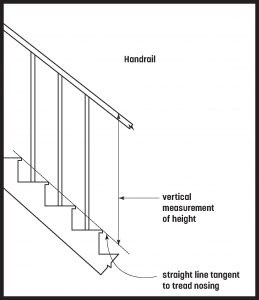
Handrail Height
A handrail must be between 865mm and 1070mm (34” and 42”) above the nosing. In the U.S., the I-Codes require handrails placed between 34” and 38”. In commercial applications, the NBC permits the top or a guard (42″ minimum height) to also serve as a handrail. In the U.S., once a stair has a 30″ drop, a guard (42″ minimum) and a handrail (34″ to 38″) would both be required.
Handrail Graspability
In the NBC, handrails must be “graspable”. In keeping with the prescriptive nature of the NBC, that is not defined. The NBC notes the graspable portion of a handrail should allow a person to comfortably grab hold by allowing their fingers and thumb to curl under part of the handrail or have a recess that is sufficiently wide and deep to accommodate a person’s fingers. But, Ontario does have specific requirements on handrail size. Always confirm local requirements.
Handrail Bracket Clearance
The NBC requires a 2” minimum clearance between the wall and handrail. If the wall surface is considered “rough”, that clearance should be 2-3/8”.
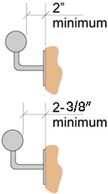
Handrail Extensions
In the NBC, handrails must "be terminated in a manner that will not obstruct pedestrian travel or create a hazard [...] one approach to reducing potential hazards is returning the handrail to a wall, floor or post.”
While the NBC leaves room for interpretation, Ontario has very specific requirements regarding extensions which are more in keeping with those in the U.S. Confirm with your local jurisdiction.
Guard
Guards are in place to prevent accidental falls. Guards are generally not required unless there is a 600mm (24”) drop (The I-Codes require guards once there is a 30”). Minimum height of 1070mm (42”) in commercial applications and 900mm (36”) in residential applications. Guards have an opening limitation of 100mm (3-7/8”).
Climbability Restrictions
Unlike the I-Codes, the NBC does have climbability restrictions for guards.
The 2015 NBC does note, however, that climbability restrictions are required for levels above 4.2 meters (13′-9″) above the adjacent level. This is a change from the 2010 NBC which required climbability restrictions on all guards. Confirm with your local jurisdiction as at the time of this writing, Ontario had not yet adopted the 2020 NBC and still requires climbability restrictions on all guards. Climbability restrictions do not apply for guards in industrial applications where children are not expected to be present.
Acceptable Design Examples
The following are design examples which the NBC has determined to be non-climbable:
- Protrusions that are greater than 450mm (18”) apart horizontally and vertically are considered sufficiently far apart to reduce the likelihood of climbing.
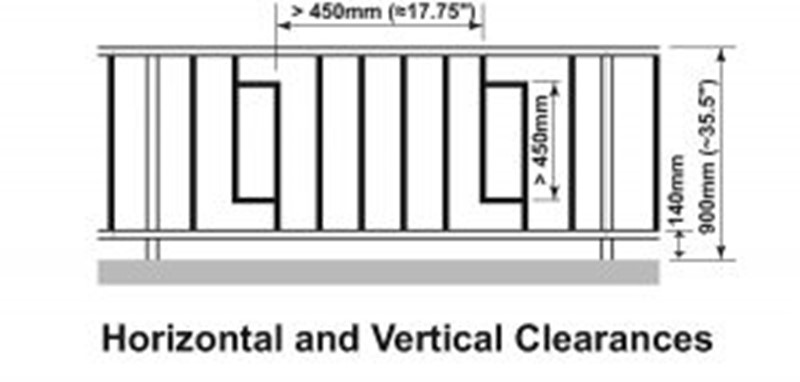
- Protrusions that present a horizontal offset of 15mm (1/2”) or less are considered to not provide a sufficient foot purchase to facilitate climbing.
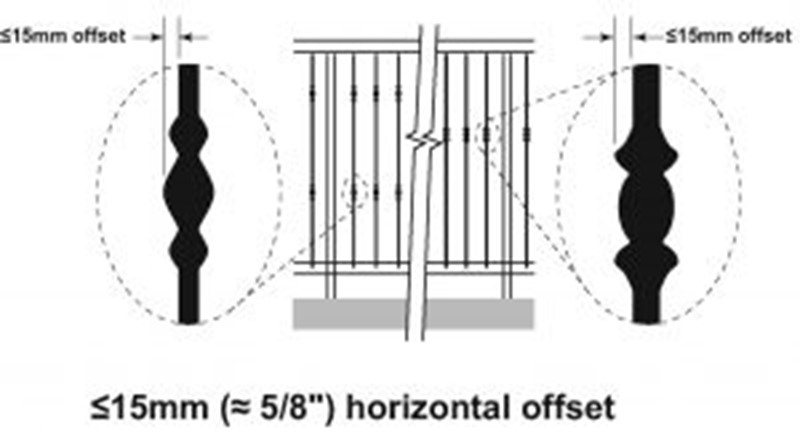
- Designs incorporating spaces that are not more than 45mm (1-3/4”) wide and 200mm (3/4”) high is considered not to facilitate climbing.
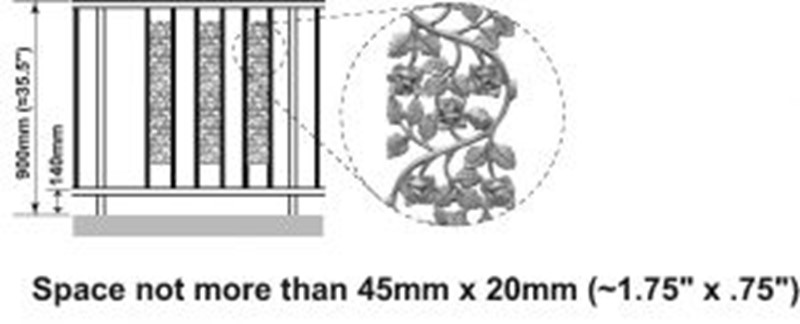
- Protrusions that present more than a 2-in-1 slope on the offset are considered to not facilitate climbing.
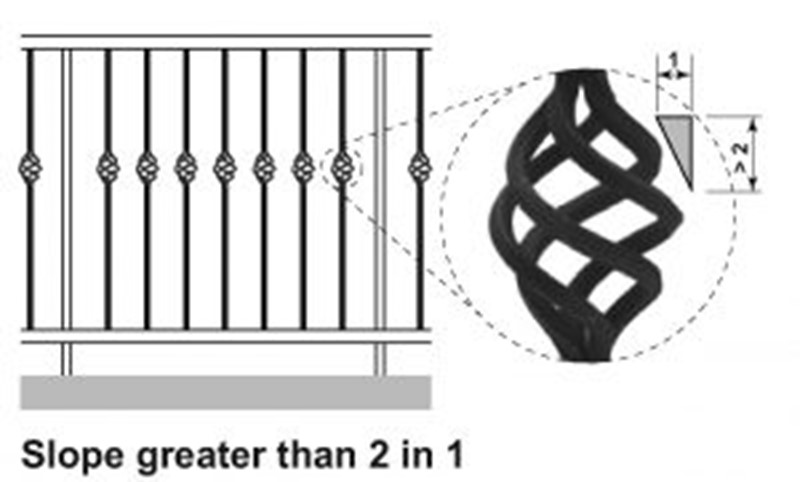
Load Requirements for Guards
| Location of Guard | Minimum Specified Loads | ||
| Horizontal Load Applied Inward or Outward at any Point at the Minimum Required Height of the Guard | Horizontal Load Applied Outward on Elements Within the Guard, Including Solid Panels and Balusters | Evenly distributed Vertical Load Applied at the Top of the Guard | |
| Guards within dwelling units and exterior guards serving not more than 2 dwelling units | 0.5 kN/m (34 lb/ft) OR concentrated load of 1.0 Kn (225 lbs) applied at any point | 0.5 kN (112 lbs) applied over a maximum width of 300mm (12”) and a height of 300 mm (12”). | 1.5 kN/m (103 lb/ft) |
| Guards serving access ways to equipment platforms and similar areas where the gathering of many people is improbable | Concentrated load of 1.0 kN (225 lbs) applied at any point. | Concentrated load of 0.5 kN (112 lbs) over an area of 100mm by 100mm (3-7/8” by 3-7/8”) located at any point on the element or elements so as to produce the most critical effect. | |
| All other guards | 0.75 kN/M (51 lb/ft) OR concentrated load of 1.0 kN (225 lbs) applied at any point. | ||
Load Requirements for Handrail
Handrails and their supports shall be designed and constructed to withstand the following loads which are not to be considered to act simultaneously:
- A concentrated load of not less than 0.9 kN (202 lbs); or
- A uniform load of 0.7 kN/m (48 lb/ft)
Have a question? Get in contact with one of our experts here.
